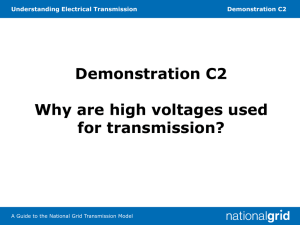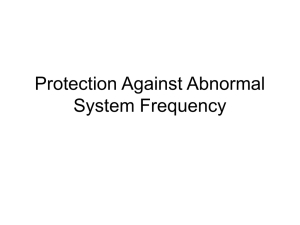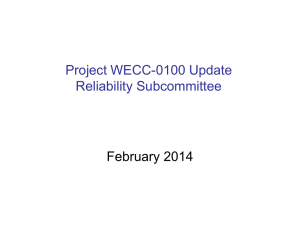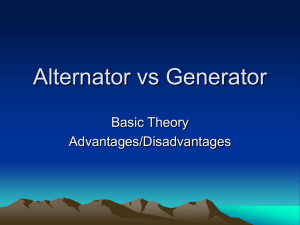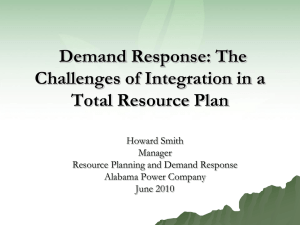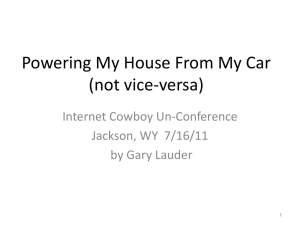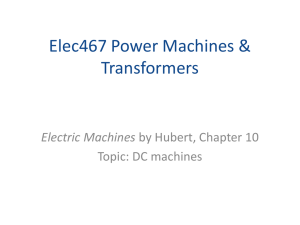DC_Machines_week_4
advertisement
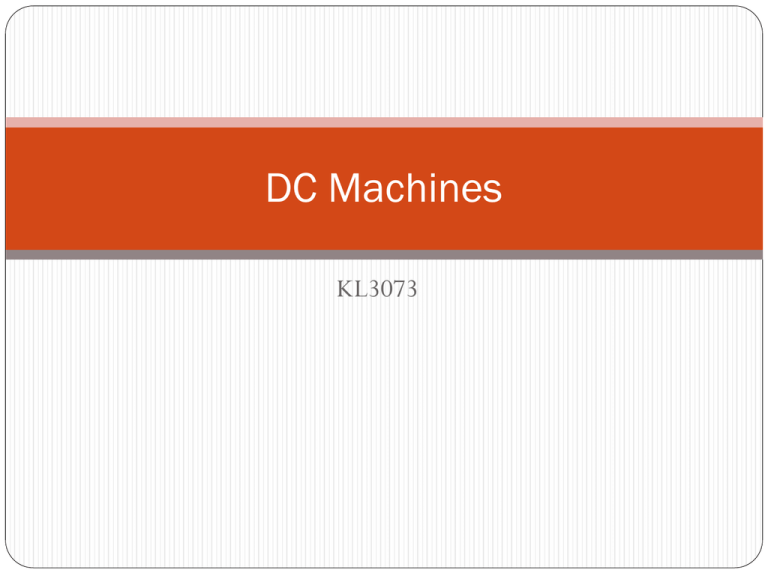
DC Machines KL3073 Direct Current (DC) Machines Fundamentals Generator action: An emf (voltage) is induced in a conductor if it moves through a magnetic field. Motor action: A force is induced in a conductor that has a current going through it and placed in a magnetic field. Any DC machine can act either as a generator or as a motor. Simplest rotating dc machine It consists of a single loop of wire rotating about a fixed axis. The rotating part is called rotor, and the stationary part is the stator. The magnetic field for the machine is supplied by the magnetic north and south poles. With uniform air gap, the reluctance is same under the pole faces. The Voltage Induced in a Rotating Loop If the rotor is rotated, a voltage will be induced in the wire loop. The voltage on each segment is given by eind = (v x B) . l The total induced voltage on the loop is: eind = 2vBl The Voltage Induced in a Rotating Loop When the loop rotates through 180°, segment ab is under the opposite pole face the direction of the voltage on the segment reverses its magnitude remains constant The resulting voltage etot The Voltage Induced in a Rotating Loop The induced voltage equation can be expressed alternatively as In general, the voltage in any real machine will depend on the same 3 factors: 1.the flux in the machine 2.The speed of rotation 3.A constant representing the construction of the machine. Getting DC voltage out of the Rotating Loop Using a mechanism called commutator and brushes dc voltage can be obtained from ac voltage •at the instant when the voltage in the loop is zero, the contacts shortcircuit the two segments •every time the voltage of the loop switches direction, the contacts also switches connections This connection-switching process is known as commutation Induced Torque in the Rotating Loop The force and the torque on a segment of the loop is given by The resulting total induced torque in the loop is ind = 2 rilB= (2Фi)/π Induced Torque in the Rotating Loop In general, the torque in any real machine will depend on the same 3 factors: 1.The flux in the machine 2.The current in the machine 3.A constant representing the construction of the machine. DC Machine Construction The stator of the dc machine has poles, which are excited by either dc current or permanent magnets to produce magnetic fields. In the neutral zone, in the middle between the poles, commutating poles are placed to reduce sparking of the commutator. Compensating windings are mounted on the main poles. These reduces flux weakening commutation problems. DC Machine Construction The poles are mounted on an iron core that provides a closed magnetic circuit. The rotor has a ring- shaped laminated core with slots. iron Coils with several turns are placed in the slots. The distance between the two legs of the coil is about 180 electric degrees. DC Machine Construction The rotor coils are connected in series through the commutator segments. The ends of each coil are connected to a commutator segment. The commutator consists of insulated copper segments mounted on an insulated tube. Rotation Ir_dc/2 Brush Ir_dc/2 Ir_dc Shaft Two brushes are pressed to the commutator to permit current flow and they are placed in neutral zone. Pole winding | 1 2 8 N 3 7 6 S 4 5 Insulation Rotor Winding Ir_dc Copper segment DC Machine Construction The rotor coils are connected in series through the commutator segments. The ends of each coil are connected to a commutator segment. The commutator consists of insulated copper segments mounted on an insulated tube. Rotation Ir_dc/2 Brush Ir_dc/2 Ir_dc Shaft Pole winding | 1 2 8 Two brushes are pressed to the commutator to permit current flow and they are placed in neutral zone. N 3 7 6 S 4 5 Insulation Rotor Winding Ir_dc Copper segment Commutation Process Commutation is the process of converting the ac voltages and currents in the rotor of a dc machine to dc voltages and currents at its terminals. The 4 loops of this machine are laid into the slots in a special manner. The “unprimed” end of each loop is the outermost wire in each slot, while the “primed” end of each loop is the innermost wire in the slot directly opposite. Commutation Process The voltage in each of the 1, 2, 3’ and 4’ ends of the loops is given by: eind = vBl (+out of page) The voltage in each of the 1’, 2’, 3 and 4 ends of the loops is given by: eind = vBl (+into page) the total voltage at the brushes E=4e The winding’s connections Commutation Process The machine at time ωt=45°. Commutation Process the 1’, 2, 3, and 4’ ends of the loops are under the north pole face the 1, 2’, 3’ and 4 ends of the loops are under the south pole face so the terminal voltage E=4e The machine at time ωt=90°. Problems with Commutation in Real Machines Armature reaction The current though the armature conductors set up a magnetic field surrounding it which has the following effects Weakens the main flux Distorts the main flux Neutral plan shift Problems with Commutation in Real Machines L(di/dt) Voltage Occurs in the commutator segments being shorted out by the brushes > inductive kick These effects causes • Arcing and sparking at the brushes •Flashover •Reduce brush life •Pitting of the commutator segment Solutions to Problems with Commutation in Real Machines Brush shifting Commutating poles or interpoles Compensating windings Solutions to Problems with Commutation in Real Machines Commutating poles or interpoles It cancels the voltage in the coils undergoing commutation interpole windings are in series with the rotor windings as the rotor current incleases flux produced by interpole also inceases producing an oppssing effect to that of neutral plan shift Solutions to Problems with Commutation in Real Machines Compensating winding Solves the problem of flux weakening and neutral plane shift Compensating windings are in series with the rotor windings placing in slots carved in the faces of the poles parallel to the rotor conductors The Internal Generated Voltage Equations Of Real Machines The induced voltage in any given machine depends on three factors: The flux Φ in the machine The speed ω of the machine's rotor A constant depending on the construction of the machine The voltage out of a real machine = the number of conductors per current path x the voltage on each conductor the voltage equation in terms of rpm The Induce Torque Equations Of Real Machines The torque in any dc machine depends on three factors: The flux Φ in the machine The armature (or rotor) current IA in the machine A constant depending on the construction of the machine The torque on the armature of a real machine =the number of conductors Z x the torque on each conductor Power Flow and Losses in DC Machines Electrical or copper losses (I2 R losses) Brush losses Brush losses Core losses Mechanical losses Stray load losses Core losses Copper losses Armature loss: Field loss: the hysteresis losses and eddy current losses occurring in the metal of the motor. These losses vary as B2 and, for the rotor, as the (n1.5) Power Flow and Losses in DC Machines Mechanical losses Friction losses are losses caused by the friction of the bearings in the machine Windage losses are caused by the friction between the moving parts of the machine and the air inside the motor's casing Stray losses Unknown losses By convention to be 1 percent of full load The Power-Flow Diagram Power-flow diagrams for Generator Power-flow diagrams for Motor. DC GENERATORS There are four major types of DC generators, namely Separately excited generator. Shunt generator. Series generator Compounded generator Cumulative Differential The Equivalent Circuit of a DC Generator Two circuits are involved in DC generators Armature Circuit Field circuit Armature circuit represents Thevenin equivalent of the entire rotor. It cantain an ideal voltage source EA and a resistor RA. . Brush voltage drop is represented by a small battery The field coils, which produce the magnetic flux inductor LF and resistor RF Radj for field current control Magnetizing curve of a DC Generator & performance The internal generated voltage EA of a dc generator is given by EA is directly proportional to the flux The field current is directly proportional to the magnetomotive force and hence EA Brush voltage drop is represented by a small battery Performance of the DC generators are determined by terminal output parameter IL and VT Voltage regulation also determines its performance The Separately Excited Generator A separately excited dc generator is a generator whose field current is supplied by a separate external dc voltage source. A separately excited dc generator By Kirchhoff's voltage law, the terminal voltage is Since the internal generated voltage is independent of lA the terminal characteristic of the separately excited generator is a straight line The terminal characteristic (a) with and (b) without compensating windings The Separately Excited Generator Control of Terminal Voltage > two methods Change the speed of rotation EA = KФω↑ >VT = EA ↑ - lARA > VT ↑ Change the field current. IF = VF/RF↓ > IF ↑ > Ф ↑> EA = KФ↑ω > VT = EA ↑ - lA RA > VT ↑ The terminal characteristic (a) with and (b) without compensating windings The Separately Excited Generator It is not possible to predict analytically the value of EA to be expected from a given field current. Magnetization curve of the generator must be used to calculte EA accurately. Net mmf is and IF equivalent is The magnetization curves for a generator are drawn for a particular speed, usually the rated speed of the machine. If the machine is turning at other speeds than the EA in a machine is related to speed by The Shunt Generator A shunt dc generator is a dc generator that supplies its own field current by having its field connected directly across the terminals of the machine. The armature current of the machine supplies both the field circuit and the load The equivalent circuit of a shunt de generator The Shunt Generator Voltage Build up in a Shunt Generator depends on Residual flux IF = VT ↑/RF > EA = KФ↑ω > VT = EA ↑ - lA RA > VT ↑ Voltage buildup on starting in a shunt dc generator possible causes for the voltage to fail to build up during starting There may be no residual magnetic flux The direction of rotation of the generator may have been reversed The field resistance may be adjusted to a value greater than the critical resistance The Shunt Generator The Terminal Characteristic of a Shunt DC Generator IA = IL ↑ + IF > (lARA ) ↑ > VT ↓ = EA - IA ↑ RA IF ↓ = VT ↓ /RF > EA = KФ ↓ ω > VT = EA ↓ - lA RA > VT ↓ Voltage Control for a Shunt DC Generator Change the shaft speed ω of the generator. Change the field resistor of the generator, The terminal characteristic of a shunt dc generator The Shunt Generator The Non linear Analysis of Shunt DC Generators The key to understanding the graphical analysis of shunt generators is to remember Kirchhoff's voltage law (KVL): The field resistance RF, which is just equal to VT/IF, a straight line At no load VT = EA The differnce between VT and EA is lARA graphical analysis of shunt generators The Shunt Generator If armature reaction is present in a shunt generator There is demagnetizing magnetomotive force and lARA drop graphical analysis of shunt generators with armature reaction The Shunt Generator The Shunt Generator THE SERIES DC GENERATOR A series dc generator is a generator whose field is connected in series with its armature. It has few turns of field coil with thick conductors. The equivalent circuit of a series generator THE SERIES DC GENERATOR The Terminal Characteristic of a Series Generator At no load As IL ↑= IA = IF > EA ↑ - IA ↑ (RF +RA) At the beginning EA increases more than the resistive drop Derivation of the terminal characteristic for a series dc generator CUMULATIVELY COMPOUNDED DC GENERATOR A cumulatively compounded dc generator is a dc generator with both series and shunt fields, connected so that the magnetomotive forces from the two fields are additive. Voltage and current relationships for this generator are The equivalent circuit of a compound dc generator Since there are series and shunt field coils, the equivalent effective shunt field current for this machine is given by The Compound Generator The Terminal Characteristic of a Cumulatively Compounded DC Generator Since IA = IF + IL ↑, the armature current IA increases too. At this point two effects occur in the generator: As IA increases, VT ↓ = EA - IA ↑ (RA + Rs). As IA increases, , increasing The field resistance RF, which is just equal to VT/IF, a straight line VT = EA ↑- IA(RA + Rs) rise. Terminal characteristics of cumulatively compounded dc generators The Compound Generator Graphical Analysis of Cumulatively Compounded DC Generators The following two equations are the key to graphically describing the terminal characteristics of a cumulatively compounded dc generator. The equivalent shunt field current Ieq , the total effective shunt field current This equivalent current Ieq represents a horizontal distance to the left or the right of the field resistance line (RF = VT/IF) along the axes of the magnetization curve. and
